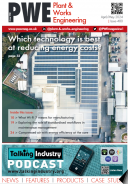Guidance on compressors
Published: 04 February, 2015
The British Fluid Power Association publication ‘Fluid Power Engineer’s Data Book’ is a valuable source of information covering a wide range of technical topics related to hydraulic and pneumatic installation and maintenance. One critical theme covered is that of correct choice and usage of air compressors. This article outlines some of the key points covered within the book.
Compressors
As most industrial factory and machine-shop type pneumatic equipment operates at about six bar, it is usual to select the compressor installation delivering seven bar into the mains, to allow for pipe losses.
Types of compressor
Displacement compressors
Air is compressed by contracting the space containing air taken in at atmospheric pressure e.g. reciprocating compressors – piston diaphragm type; rotary compressors – sliding vane, gear, screw, roots blower.
Dynamic compressors
Compression is achieved by converting that air inlet rate into a pressure, e.g. centrifugal compressors – radial impeller, blade type, axial compressors.
Overlap occurs between the various types in terms of capacity and pressure range but some generalisation can be made. Use reciprocating compressors if very high pressures, up to 1000 bar, are required. Rotary compressors, either screw or vane, are used for medium pressures up to 14 bar and flow capacities up to 3600 cu.m/hr. Above this dynamic compressors may be a better choice for larger flow rates. Blowers are used for large volumes of low-pressure air, up to 1 bar.
Sizes
For industrial application compressors can be classified:
Small: up to 40 L/s
Medium: 40 L/s to 300 L/s
Large: above 300 L/s
Installation
Three types of installation dependent on application:
Portable
A compressor, sometimes skid-mounted, which is capable of being lifted and transported from one operating site to another. A portable compressor is never wheel-mounted.
Mobile
A compressor either trailer- or vehicle-mounted which is designed to be frequently moved from one operating site to another. A mobile compressor is always wheel-mounted.
Fixed
A compressor which is designed to be used at a permanent location and usually remains in a fixed position throughout its working life.
Prime movers
Selection drive unit is essential to obtain efficient and economic supply. Three basic types:
Electric motors
Used for compactness and ease of control.
IC engine
(Diesel, petrol, gas) for mobile units, emergency stand-by sets or where an electrical supply is not available.
Turbine
(Gas, steam) can be incorporated into the total energy system of plants using existing steam or gas supplies.
Selection factors
Delivery pressure
Must be high enough for all existing and potential future requirements. If there is a special requirement for a large volume of either high or low air pressure, it may be better to install a separate unit for that purpose.
Capacity
Calculate not only the average air consumption but also maximum instantaneous demands, e.g. large bore cylinders and air motors, operating at high speeds. Determine use factors. Frequently users add to existing airlines indiscriminately and run out of air.
Intake siting
Intake air should be as clean and as cold as possible for maximum efficiency.
Intake filter
A device having a low-pressure drop to remove abrasive materials which could lead to rapid wear.
Air quality
Study air quality requirements throughout the system or plant. The correct combinations of separators, aftercoolers, outlet filters and dryers should be determined. The problem of water removal should not be left to the airline filters associated with individual plant and systems.
Stand-by capacity
That which is required in an emergency or when an individual compressor requires servicing.
Air receiver
The system must have adequate storage requirements, not only to meet demand but also to ensure efficient running of the prime mover.
Air main capacity
A large bore ring main acts as a useful receiver, and reduces pressure drops and operating costs. The cost of larger size of pipework is only a small proportion of the installation costs.
More information
The BFPA publication ‘Fluid Power Engineer’s Data Book’ is available by contacting the Association at info@bfpa.co.uk, or Tel: 01608 647900.






